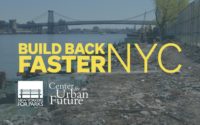
By Adam Ganser and Jonathan Bowles
August 30, 2022
The pandemic has led New Yorkers to embrace the city's social infrastructure like never before, at parks, playgrounds, libraries and cultural venues. New York's arcane and inefficient system for building and repairing its critical public assets, however, is preventing our limited capital dollars from meeting the full scale of needs across the five boroughs.
From inception and design to procurement and construction, building in New York takes longer and costs exponentially more than it should. Typical park and library projects take up to eight years to complete, according to Center for an Urban Future research.
Parks struggle with maintenance backlogs, aging branch libraries close for longer than they should, public bathrooms remain unbuilt, child care centers are left in disrepair, and community and cultural organizations wait years for capital needs to be addressed.
The urgency of maintaining and upgrading our social infrastructure is heightened by the fact that the city's community resources are withering when New Yorkers are depending on them more.
On average, city parks are now 73 years old. The Parks Department faces an estimated backlog of $6 billion in capital work.
Those numbers continue to grow as the city's capital construction process remains stuck in low gear.
To achieve major cost and time savings, the city must streamline bureaucratic processes across the network of agencies that are bogged down in a system marked by layers of redundancy and inefficiency.
New task force
Mayor Eric Adams took a step toward doing so when he convened a capital process reform task force, charged with speeding up the time it takes for the city to complete projects.
Change is not only necessary, it's achievable. The city Department of Design and Construction, which manages many city-funded capital projects, has made meaningful progress under its 2019 strategic blueprint, reducing the average time to get projects done by about six months. Likewise, the Parks Department has made process improvements that are starting to show results.
Building on those successful innovations, the Adams administration and the City Council should implement broader systemic reforms that help New York reduce the time it takes to build and repair public infrastructure and buildings.
A new campaign, Build Back Faster NYC, is calling on the mayor and council to reduce the time it takes to build in New York by 25%—or about two years per project.
Cutting red tape from the city's capital process would be a major victory for all New Yorkers. The savings could top $800 million during the next five years. That's enough to pay for 150 full-time parks workers, fund 1,300 miles of protected bike lanes or clear nearly all the state-of-good-repair needs across the city's three library systems.
Overhauling a process this complex and unwieldy requires dedicated efforts toward solutions and better results from the Adams administration, the council, capital and oversight agencies and public libraries.
Set and measure goals
Adams should begin by calling on all the agencies and entities with an oversight role in the capital process to deliver a strategic blueprint detailing steps to reduce project durations by 25%.
The council could help set and measure the goals. Its finance, contracts and oversight committees should organize a hearing focused on capital process inefficiencies across agencies and opportunities for improvement.
City officials believe reforming the capital process is necessary, but the complexity of the issue—and a lack of prioritization—have stymied efforts to fix it.
Our parks and open spaces, libraries, schools and hospitals are the foundation of a more equitable city. Now is the time for a recovery that's not just bold but smart, to build back more efficiently. New York's current leaders can make it happen.
Read the article online at Crain's New York Business
